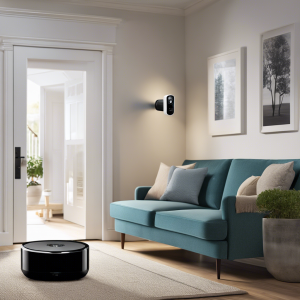In today’s increasingly connected world, ensuring the safety and security of our homes has become a top priority. With the wide range of home security systems available in the market, it can be overwhelming to choose the right one for your needs.
However, by considering advanced features, you can enhance the overall effectiveness and convenience of your home security system. From wireless connectivity and video surveillance to mobile app integration and home automation compatibility, these advanced features offer a new level of control and peace of mind.

But what other advanced features should you be looking for in a home security system? Stay tuned as we explore some of the most crucial features that can help you enhance the security and protection of your home.
1. Wireless Connectivity
Wireless connectivity is an essential feature of modern home security systems, providing convenient and reliable communication between various components.
With the advent of smart home technology, homeowners can now control and monitor their security systems remotely, thanks to wireless connectivity.
This technology allows the integration of different security devices and sensors, such as cameras, motion detectors, and door/window sensors, creating a comprehensive and interconnected security network.
One of the advantages of wireless connectivity in home security systems is the ability to control and manage the system using voice commands.
With the rise of voice control technology, homeowners can now interact with their security systems effortlessly. By simply using voice commands, they can arm or disarm the system, check the status of sensors, or even view live feeds from security cameras.
This hands-free approach not only enhances convenience but also improves accessibility for individuals with mobility challenges or disabilities.
Wireless connectivity also plays a crucial role in the responsiveness and reliability of home security systems.
Unlike traditional wired systems, wireless connections eliminate the need for physical cables, making installation easier and more flexible.
Additionally, wireless connections are not susceptible to physical damage or interference, ensuring uninterrupted communication between the different components of the security system.
Furthermore, wireless connectivity allows for seamless integration with other smart home devices. Homeowners can integrate their security systems with voice assistants, such as Amazon Alexa or Google Assistant, enabling them to control their security system alongside other smart home devices, like lights, thermostats, and locks.
This integration enhances the overall functionality and convenience of the smart home ecosystem.
2. Video Surveillance
With the integration of wireless connectivity in home security systems, video surveillance becomes a crucial component for enhancing the overall security and monitoring capabilities of the system. Video surveillance allows homeowners to have a clear view of their property at all times, providing an extra layer of protection against potential threats.
One of the key features to look for in a video surveillance system is night vision capability. This feature ensures that the cameras can capture clear and detailed footage even in low-light or dark environments, such as during nighttime or in poorly lit areas. By having night vision cameras, homeowners can rest assured knowing that their property is being monitored round the clock, regardless of the lighting conditions.
Another important feature to consider is cloud storage. Traditional video surveillance systems often rely on local storage devices, such as DVRs or NVRs, which can be vulnerable to theft or damage.
Cloud storage, on the other hand, offers a more secure and reliable solution. By storing the video footage in the cloud, homeowners can access and review the recordings remotely from any device with an internet connection. This not only provides convenience but also ensures that the footage is safely stored off-site, and protected from physical damage or tampering.
Furthermore, cloud storage allows for easy scalability. Homeowners can easily expand their storage capacity as needed, without the hassle of purchasing additional hardware. Additionally, cloud storage often includes advanced features like motion detection and video analytics, which can help homeowners quickly identify and respond to any suspicious activity.
3. Mobile App Integration
Mobile app integration is a key feature that enhances the functionality and convenience of a home security system.
With smartphone control, homeowners can easily arm or disarm their security system, monitor their homes in real-time, and receive alerts and notifications directly on their mobile devices. This level of control and accessibility provides peace of mind and allows homeowners to stay connected to their home security system no matter where they are.
One of the significant advantages of mobile app integration is geofencing technology. Geofencing uses GPS or RFID technology to create a virtual boundary around a specific location, such as a home or property.
When the homeowner’s smartphone enters or exits this boundary, the home security system can automatically perform certain actions. For example, when the homeowner leaves the geofenced area, the system can arm itself and activate the surveillance cameras. Conversely, when the homeowner returns, the system can disarm and deactivate the cameras. This automation eliminates the need for manual operation and ensures that the home is always protected.
To further illustrate the benefits of mobile app integration, consider the following table:
| Feature | Description |
|---|---|
| Smartphone control | Allows homeowners to control their security system from anywhere |
| Real-time monitoring | Provides live video feeds and updates on the home’s security status |
| Alerts and notifications | Sends instant notifications to the homeowner’s smartphone |
Home Automation Compatibility
Home automation compatibility is an essential aspect to consider when choosing a home security system.
With the rise of smart homes, integrating your security system with other automated devices can greatly enhance the overall functionality and convenience of your home. Here are some reasons why home automation compatibility should be a priority when selecting a security system:
-
Voice control: The ability to control your security system through voice commands adds an extra layer of convenience and ease of use. With voice control, you can arm or disarm your system, check the status of your security devices, and even receive real-time notifications, all without lifting a finger.
-
Energy efficiency: Integrating your security system with other automated devices in your home can lead to increased energy efficiency. For example, you can set your lights to automatically turn off when the security system is armed, or adjust the thermostat based on the occupancy status of your home. This not only saves energy but also helps reduce utility bills.
-
Seamless automation: A compatible security system allows for seamless integration with other smart home devices such as door locks, cameras, motion sensors, and smart appliances. This creates a cohesive ecosystem where all your devices work together to enhance security and provide a seamless automation experience.
-
Remote access: Home automation compatibility enables you to remotely access and control your security system from anywhere using your smartphone or tablet. Whether you’re at work, on vacation, or simply away from home, you can monitor and manage your security devices with ease, giving you peace of mind.
4. Two-Way Audio Communication
One important feature to consider when selecting a home security system is the capability for two-way audio communication. This feature allows homeowners to have real-time communication with anyone on their property, whether it’s a family member, a visitor, or even a potential intruder. Two-way audio communication enhances the effectiveness of a security system by providing an additional layer of interaction and control.
One of the key benefits of two-way audio communication is the ability to use voice recognition technology. This feature allows homeowners to easily identify and communicate with individuals who approach their property. By using voice recognition, the security system can be programmed to alert homeowners when someone unfamiliar is detected, providing an added level of security and peace of mind.
In addition to voice recognition, two-way audio communication also enables emergency alerts. In the case of an emergency, such as a fire or medical situation, homeowners can use the system to quickly communicate with emergency services. This can be especially useful if a family member is unable to physically reach a phone or if there is a need for immediate assistance.
5. Facial Recognition Technology
Facial recognition technology has become an increasingly popular feature in home security systems due to its ability to provide an additional layer of protection. By using advanced facial recognition algorithms, these systems can identify individuals and match them against a database of known faces, allowing homeowners to have greater control over who has access to their property.

Here are some key benefits of incorporating facial recognition technology into a home security system:
-
Enhanced security: Facial recognition technology can accurately identify authorized individuals, enabling homeowners to monitor who enters and exits their property. This feature can help deter potential burglars or intruders, providing a higher level of security.
-
Convenience: With facial recognition technology, homeowners can enjoy a seamless and hassle-free entry experience. By eliminating the need for traditional keys or access codes, individuals can easily access their homes with just their faces, making it more convenient for residents and authorized visitors.
-
Real-time alerts: Home security systems equipped with facial recognition capabilities can instantly send alerts to homeowners’ smartphones or other devices when an unrecognized face is detected. This allows homeowners to take immediate action and notify authorities if necessary, providing a swift response to potential security threats.
-
Peace of mind: Facial recognition technology can provide homeowners with peace of mind by enhancing the overall security of their homes. By accurately identifying individuals, it reduces the risk of unauthorized access and increases the chances of identifying potential suspects in the event of a security breach.
However, it is important to address the privacy concerns and ethical implications associated with facial recognition technology. As this technology becomes more prevalent, it is essential to implement proper safeguards to protect individuals’ privacy and ensure responsible use.
6. Advanced Motion Detection
Utilizing cutting-edge technology, advanced motion detection systems play a crucial role in bolstering the security of residential properties.
These systems are designed to detect any movement within the monitored area and provide homeowners with a proactive approach to home security. With the ability to differentiate between human and non-human movement, advanced motion detection systems ensure that homeowners receive accurate alerts, minimizing false alarms and enhancing overall security.
One of the key features of advanced motion detection systems is the ability to provide interactive alerts. When motion is detected, homeowners receive real-time notifications on their smartphones or other connected devices.
This allows them to take immediate action, whether it’s contacting the authorities or remotely accessing surveillance cameras to assess the situation. By enabling homeowners to respond quickly to potential threats, interactive alerts provide an added layer of security and peace of mind.
Furthermore, advanced motion detection systems leverage advanced analytics to enhance their capabilities. These systems use sophisticated algorithms to analyze the motion patterns within the monitored area. By taking into account factors such as time of day, location, and previous activity, advanced analytics can distinguish between normal household movements and suspicious activities. This helps to minimize false alarms and ensures that homeowners are alerted only when there is a genuine cause for concern.
7. Remote Access and Control
With the ability to respond quickly to potential threats and enhance overall security, the next important feature to consider is remote access and control. This feature allows homeowners to monitor and control their home security system from anywhere, providing peace of mind and convenience.
Here are some key benefits of remote access and control:
-
Convenience: Remote access and control enable homeowners to manage their security system remotely, whether they are at work, on vacation, or simply away from home. With just a few taps on their smartphone, they can arm or disarm the system, check the status of their cameras, and receive real-time alerts.
-
Cloud storage: Remote access often includes the option for cloud storage, which allows homeowners to store and access their security footage remotely. In the event of a break-in or other incident, having access to recorded footage can be invaluable for identifying perpetrators and providing evidence to law enforcement.
-
Enhanced security: By being able to remotely monitor their security system, homeowners can quickly respond to any suspicious activity or potential threats. They can also make adjustments to their system settings in real-time, ensuring that their home is always protected.
-
Voice control: With the integration of voice control technology, homeowners can now control their security system using voice commands. This hands-free approach adds an extra layer of convenience and ease of use, allowing users to easily arm or disarm the system without having to physically interact with their devices.
8. Environmental Monitoring
Environmental monitoring is a crucial feature of a home security system that ensures the safety and well-being of homeowners and their property. One important aspect of environmental monitoring is air quality monitoring. Poor air quality can lead to various health issues, such as allergies, respiratory problems, or even serious illnesses. A home security system equipped with air quality monitoring sensors can detect harmful pollutants, such as carbon monoxide, smoke, or volatile organic compounds (VOCs). When abnormal levels are detected, the system can send alerts to the homeowners and authorities, allowing for immediate action to be taken to prevent further harm.
Another essential aspect of environmental monitoring is water leak detection. Water leaks can cause significant damage to a home, leading to mold growth, structural damage, and costly repairs. A home security system with water leak detection sensors can detect even the smallest leaks, such as those from a burst pipe or a malfunctioning appliance. When a leak is detected, the system can send alerts to the homeowners, enabling them to take prompt action and minimize the potential damage.
9. Professional Monitoring Services
Home security systems equipped with professional monitoring services offer an additional layer of protection for homeowners and their property. These services provide round-the-clock surveillance and prompt response to any security breach or emergency. Here are some key advantages of opting for professional monitoring services:
-
Peace of mind: Knowing that your home is being monitored by professionals can give you a sense of security and peace of mind, especially when you are away or unable to monitor your property yourself.
-
Expertise and experience: Professional monitoring services are provided by trained professionals who have extensive knowledge and experience in the field of security. They are equipped to handle any situation effectively and efficiently, ensuring the safety of your home and loved ones.
-
Immediate response: In the event of a security breach or emergency, professional monitoring services provide immediate response. They can contact the authorities, dispatch emergency personnel, or take necessary action to mitigate the situation, even if you are unable to do so yourself.
-
Integration with other security features: Professional monitoring services can be integrated with other advanced security features of your home security system, such as video surveillance, motion sensors, and door/window sensors. This allows for comprehensive monitoring and ensures that any suspicious activity is detected and addressed promptly.
When it comes to the installation of home security systems, there are two options available: professional installation and DIY installation. While DIY installation may seem more cost-effective and convenient, it may not provide the same level of expertise and reliability as professional installation.
Professional installation ensures that the security system is properly installed and optimized for maximum effectiveness. It also eliminates the risk of errors or inadequate installation, which could compromise the security of your home. Therefore, opting for professional installation is recommended to ensure the seamless integration and optimal functioning of your home security system.
Frequently Asked Questions
The average cost of a home security system that includes advanced motion detection and facial recognition technology can vary depending on factors such as the size of the property, the number of cameras required, and the specific features of the system.
However, on average, homeowners can expect to invest anywhere from $300 to $1,500 for a comprehensive security system with these technological features.
It is important to consult with security system providers to get accurate pricing information tailored to individual needs and preferences.
Integration possibilities and compatibility issues are important considerations when looking to integrate existing home automation devices with a new home security system.
Homeowners should ensure that the security system is compatible with their automation devices to enable seamless integration and control.
Compatibility can vary depending on the brand and technology used, so it’s crucial to research and select a security system that offers integration capabilities with existing devices to maximize convenience and functionality.
Remote access and control of a home security system allows homeowners to monitor and control their system from anywhere using a smartphone, tablet, or computer. This feature allows users to arm or disarm the system, view live video feeds, receive real-time alerts, and even control other connected devices in their homes.
It provides convenience and peace of mind, as users can check on their home’s security status and make adjustments even when they are not physically present.
Monitoring air quality, including smoke and carbon monoxide levels, is indeed possible with some home security systems. This advanced feature provides homeowners with an added layer of safety and peace of mind. These systems are equipped with sensors that can detect changes in air quality and alert the homeowners immediately.
In addition, many modern home security systems offer smart home integration, allowing users to monitor and control various aspects of their home security system remotely through their smartphones or other smart devices.
Professional monitoring services provide several benefits for home security systems.
Unlike self-monitoring, professional monitoring ensures round-the-clock surveillance and immediate response to any security breach or emergency situation.
It enhances the effectiveness of the system by providing a team of trained professionals who can assess the situation and take appropriate actions, such as contacting emergency services or dispatching security personnel.
Professional monitoring also offers added peace of mind, as homeowners can trust that their property is being constantly monitored and protected.



